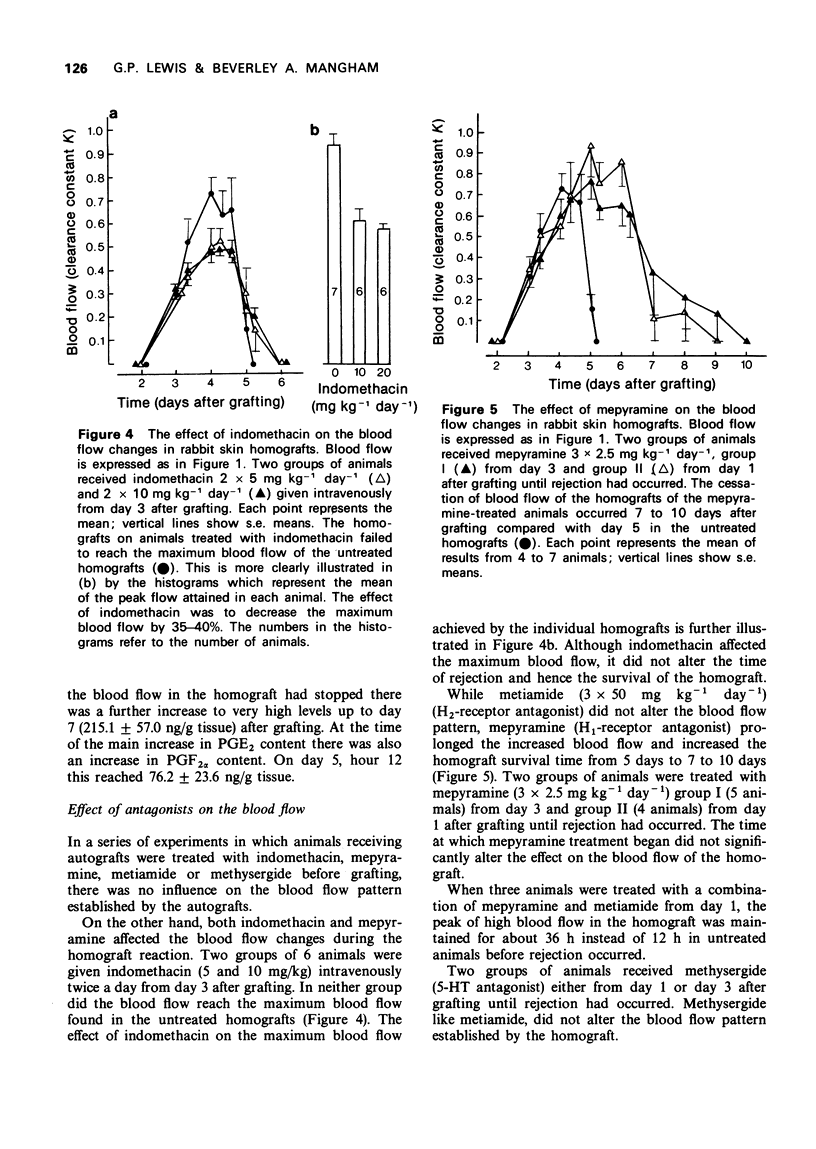Abstract
1. Blood flow changes have been measured in rabbit skin homografts and autografts and an attempt has been made to correlate these changes with the presence of vasoactive agents in homogenates of the grafts. 2. During the healing-in of both types of grafts the blood flow and histamine content increased. 3. If this histamine was responsible for the vasodilatation via an H2-receptor it must have been released in the form of "nascent" or intrinsic histamine since the vasodilatation was not antagonized by antihistamine. 4. A peak of histamine concentration occurred in homografts, more than three times that in autografts at the onset of rejection. At the same time the blood flow stopped completely. 5. This vasoconstriction might be mediated by histamine since treatment with mepyramine delayed the cessation of blood flow from 5 days up to 7 to 10 days. 6. Prostaglandins appeared to be involved only in the period of peak blood flow in homografts because indomethacin did not delay the onset of rejection, but reduced the peak blood flow in the homografts at a time when there was an increased content of prostaglandin E2 in the homograft tissue.
Full text
PDF





Selected References
These references are in PubMed. This may not be the complete list of references from this article.
- BOGDANSKI D. F., PLETSCHER A., BRODIE B. B., UNDENFRIEND S. Identification and assay of serotonin in brain. J Pharmacol Exp Ther. 1956 May;117(1):82–88. [PubMed] [Google Scholar]
- Brimblecombe R. W., Owen D. A., Parsons M. E. The cardiovascular effects of histamine in laboratory animals. Agents Actions. 1974 Aug;4(3):191–192. doi: 10.1007/BF01970270. [DOI] [PubMed] [Google Scholar]
- DALE H. Antihistamine substances. Br Med J. 1948 Aug 7;2(4570):281–283. doi: 10.1136/bmj.2.4570.281. [DOI] [PMC free article] [PubMed] [Google Scholar]
- Evans D. P., Lewis J. A., Thomson D. S. An automated fluorimetric assay for the rapid determination of histamine in biological fluids. Life Sci II. 1973 Apr 8;12(7):327–336. doi: 10.1016/0024-3205(73)90366-4. [DOI] [PubMed] [Google Scholar]
- Gilmore N., Vane J. R., Wyllie J. H. Prostaglandins released by the spleen. Nature. 1968 Jun 22;218(5147):1135–1140. doi: 10.1038/2181135a0. [DOI] [PubMed] [Google Scholar]
- Hennam J. F., Johnson D. A., Newton J. R., Collins W. P. Radioimmunoassay of prostaglandin F-2-alpha in peripheral venous plasma from men and women. Prostaglandins. 1974 Mar 25;5(6):531–542. doi: 10.1016/s0090-6980(74)80028-6. [DOI] [PubMed] [Google Scholar]
- Henney C. S., Bourne H. R., Lichtenstein L. M. The role of cyclic 3',5' adenosine monophosphate in the specific cytolytic activity of lymphocytes. J Immunol. 1972 Jun;108(6):1526–1534. [PubMed] [Google Scholar]
- Jasani M. K., Lewis G. P. Lymph flow and changes in intracellular enzymes during healing and rejection of rabbit skin grafts. J Physiol. 1971 Dec;219(3):525–554. doi: 10.1113/jphysiol.1971.sp009676. [DOI] [PMC free article] [PubMed] [Google Scholar]
- KAHLSON G. New approaches to the physiology of histamine. Perspect Biol Med. 1962;5:179–197. doi: 10.1353/pbm.1962.0027. [DOI] [PubMed] [Google Scholar]
- Lewis G. P., Peck M. J., Williams T. J., Young B. A. Proceedings: Measurement of blood flow in rabbit skin homografts and autografts using a 133Xe clearance technique. J Physiol. 1976 Jan;254(1):32P–33P. [PubMed] [Google Scholar]
- Medawar P. B. The behaviour and fate of skin autografts and skin homografts in rabbits: A report to the War Wounds Committee of the Medical Research Council. J Anat. 1944 Oct;78(Pt 5):176–199. [PMC free article] [PubMed] [Google Scholar]
- Moore T. C., Schayer R. W. Histidine decarboxylase activity of autografted and allografted rat skin. Transplantation. 1969 Feb;7(2):99–104. doi: 10.1097/00007890-196902000-00002. [DOI] [PubMed] [Google Scholar]
- SCHAYER R. W. Evidence that induced histamine is an intrinsic regulator of the microcirculatory system. Am J Physiol. 1962 Jan;202:66–72. doi: 10.1152/ajplegacy.1962.202.1.66. [DOI] [PubMed] [Google Scholar]
- SHORE P. A., BURKHALTER A., COHN V. H., Jr A method for the fluorometric assay of histamine in tissues. J Pharmacol Exp Ther. 1959 Nov;127:182–186. [PubMed] [Google Scholar]
- Sejrsen P. Blood flow in cutaneous tissue in man studied by washout of radioactive xenon. Circ Res. 1969 Aug;25(2):215–229. doi: 10.1161/01.res.25.2.215. [DOI] [PubMed] [Google Scholar]


